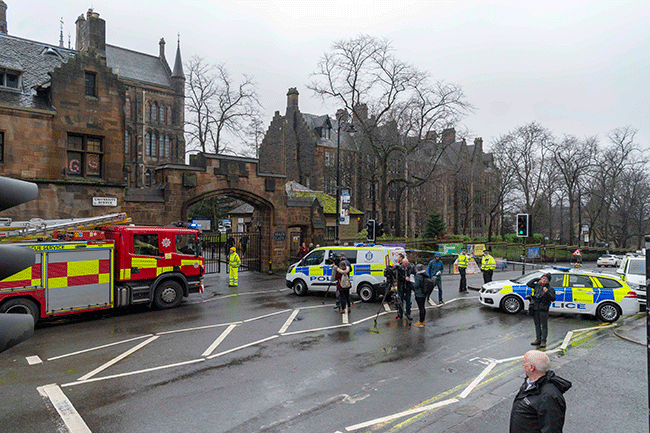A Proportionate Response?
Published: 22 March 2019
UofG Director of Communications and Public Affairs Peter Aitchison shares his thoughts on how to respond to external and internal incidents
As Director of Communications and Public Affairs for the University I have to respond to a great many issues. Some attract international news coverage, like the device which was discovered in the mail room on 6 March, but many more require difficult judgement calls – for example, how to deal with controversial comments on social media.
I work very closely with senior colleagues from the University and often with the Students' Representative Council, writes Peter Aitchison, Director of Communications and Public Affairs.
Depending on the nature of the incident we sometimes have to act very quickly, taking decisions based on the evidence to hand and the likely risks that appear.
Given our profile as an institution and our very large social media following, even the smallest of matters can attract almost instantaneous attention, including from the press. Responses have to be swiftly agreed and then communicated to different audiences through a variety of channels including direct email, the University website and on twitter.
Proportionality and perspective are important in assessing what response we should give to any particular concern. In some cases, especially when these involve the police or emergency services we have a clear strategy of what to do, and what messages are appropriate. That was certainly the situation with the suspect package which led to the evacuation of a number of buildings on Gilmorehill and the closure of University Avenue. Working closely with Police Scotland we issued multiple, consistent communications which were regularly updated across the course of the day.
We also fielded dozens of media calls.
Other issues can be more problematic.
The day after the Gilmorehill incident there was an evacuation of the Rutherford/McCowan building in Dumfries. Initially it seemed the matter would be resolved swiftly, and we held back with both internal and external messaging. On balance that was an error and although we did subsequently issue email and social media communications on what did turn out to be a false alarm, these ought to have been delivered at an earlier stage.
In the last week posters have been displayed on some of our buildings and a small amount of social media traffic from an extremist, yet legal, organisation disseminated. Some of this included direct reference to a member of staff. We acted quickly to remove the posters, reached out to our colleague and placed messages on social media to confirm that whilst we will always support free speech, we will not tolerate harassment or abuse of any kind.
Was this an appropriate response? Could we, or should we have done more? You will perhaps have noticed that I have not named the organisation involved, and nor do I intend to do so. Extremist groups feed on the reactions that their activities provoke. That is not to say that we should not condemn what they stand for, or do all that we can to ensure that our campus is a safe environment for all. But we have to do this with a sense of perspective and act in a way that is proportionate.
Tragic events around the world – some caused by terrorists or a deranged individual intent on harming others – also often require a response from the University. In the case of events such as the attacks on Muslim worshippers in New Zealand, the issue is not just to express solidarity with those directly affected; we also want to reach out to members of our own community and assure them that, whatever their faith or background, they are our brothers and sisters – an attack on one group is an affront to us all.
We regularly review how we respond to incidents, including ‘lesson’s learned’ meetings. We listen and respond to constructive criticism, and heed what bodies such as the SRC have to say.
Ultimately though, whether we are faced with a false fire alarm or a viable explosive device; the impact of a severe snow storm or a prank drone overflying campus, we have to make honest and often swift judgement calls on how to react and what to say, or not to say. We cannot be right all of the time, but the safety and security of staff and students will always be our primary concern.
First published: 22 March 2019

